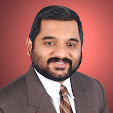Thursday, February 11, 2010
www.readersnest.com - Lending Library Online, home delivery
www.readersnest.com - Lending Library Online, home delivery: "Lendinglibrary specializing in english fiction, visit readersnest.com andrequest books. Books delivered and pickedup from your doorstep.Call 9940074572..."
Sunday, September 28, 2008
George and my weekend affair!
George woke me up as I slipped into sleep on bloggerland again. Thanks George.
Went to meet the wonderful folks organizing barcampchennai2 last week at IIT. Wanted to get a couple of sponsorships for them at Collabnet and Athena. But CTS offered to sponsor the whole event, and gave us a big helping hand. If you have a great technology idea, or tech-based social idea that you want to enrol people in, barcampchennai is the place to be. Go ahead and register yourself!
Had been to Utthiramerur twice this weekend. Saturday (coincidentally) was of purattasi, and had a great darshan at the sundaravarda perumal koil with Dr. T. S. Sathyamurthy. Then we went on to Kailasanathar temple, where our organization REACH is undertaking the temple preservation and rebuilding work. As the front mandapam (we we so forth were judging to be chola built) was brought down (it had already fallen under its own weight), we found that the mandapam construction had covered up some inscriptions. It was great to be looking at inscriptions hidden for the last few centuries.
Dr. T. S also pointed out that the basement of the mandapam was made of pure sand, and not the strong boulder structure that supported the original temple. Hence it was of different age and construction. We already knew this, but more proof was coming forth.
The steps coming out of the original temple seemed to have been broken while constructing the mandapam.
Also, since the mandapam was covering up chola inscriptions, the madapam was definitely of the post-chola age .
Dr. T.S pointed out that the inscriptions had been estampaged during 1890's and might give a clue to whether the mandapam belonged to post-1890 or pre-1890. That is if during that estampage efforts captured the so far hidden inscriptions, the mandapam was post-1890, else, it was pre-1890, the reason why they could not have gotten this inscription being the mandapam that stood there.
Great Day!
On Sunday, Shilpa forced me to attend the French classes (it is becoming boring nowadays - they have started 'talking' french in class - imagine that - how could they do that - this reminds me of sanskrit classes when I was in high school - oh the language blues!)
After the french class, was having lunch with Shilpa at a dhaba, when I was pulled into another Utthiramerur trip. This time, we were to take eminent epigraphist 'Meesai' Ramachandran, to read the newly found inscription.
Ramachandran was a very polite and humble person for someone of his reputation. He read the inscription very patiently and explained it to us even more patiently.
One highlight (apart from the mentioning of donations to the temple) was that the temple owned lands till the lake bund of a village 8 kms from Uttiramerur. One local commented that the temple now owned only one acre today!
Ramachandran also found an already exposed inscription, and commented that it was a pre-era of the inscriptions we read - this one was highly damaged, and we had to resort to a lot of techniques (it was also getting darker), and finally with a torch spraying light at a 10 degree angle to wall, he was able to decipher it to a chola king - he suspected utthama or sundara chola.
Ramachandran, also kindly agreed to teach a class reading inscriptions. He was saddened that their generation failed to continue the tradition by inspiring new people into this art(science?). I jumped right in and have taken an appointment to see him this saturday (4th October 2008) at his home. He also wanted some technical help in making reading inscriptions easier - which I feel I could help him with.
Anybody interested in joining me for the classes? Just leave a comment with your number here, will get in touch with you!
yo, then! until the next George, take care and sleep well!
Went to meet the wonderful folks organizing barcampchennai2 last week at IIT. Wanted to get a couple of sponsorships for them at Collabnet and Athena. But CTS offered to sponsor the whole event, and gave us a big helping hand. If you have a great technology idea, or tech-based social idea that you want to enrol people in, barcampchennai is the place to be. Go ahead and register yourself!
Had been to Utthiramerur twice this weekend. Saturday (coincidentally) was of purattasi, and had a great darshan at the sundaravarda perumal koil with Dr. T. S. Sathyamurthy. Then we went on to Kailasanathar temple, where our organization REACH is undertaking the temple preservation and rebuilding work. As the front mandapam (we we so forth were judging to be chola built) was brought down (it had already fallen under its own weight), we found that the mandapam construction had covered up some inscriptions. It was great to be looking at inscriptions hidden for the last few centuries.
Dr. T. S also pointed out that the basement of the mandapam was made of pure sand, and not the strong boulder structure that supported the original temple. Hence it was of different age and construction. We already knew this, but more proof was coming forth.
The steps coming out of the original temple seemed to have been broken while constructing the mandapam.
Also, since the mandapam was covering up chola inscriptions, the madapam was definitely of the post-chola age .
Dr. T.S pointed out that the inscriptions had been estampaged during 1890's and might give a clue to whether the mandapam belonged to post-1890 or pre-1890. That is if during that estampage efforts captured the so far hidden inscriptions, the mandapam was post-1890, else, it was pre-1890, the reason why they could not have gotten this inscription being the mandapam that stood there.
Great Day!
On Sunday, Shilpa forced me to attend the French classes (it is becoming boring nowadays - they have started 'talking' french in class - imagine that - how could they do that - this reminds me of sanskrit classes when I was in high school - oh the language blues!)
After the french class, was having lunch with Shilpa at a dhaba, when I was pulled into another Utthiramerur trip. This time, we were to take eminent epigraphist 'Meesai' Ramachandran, to read the newly found inscription.
Ramachandran was a very polite and humble person for someone of his reputation. He read the inscription very patiently and explained it to us even more patiently.
One highlight (apart from the mentioning of donations to the temple) was that the temple owned lands till the lake bund of a village 8 kms from Uttiramerur. One local commented that the temple now owned only one acre today!
Ramachandran also found an already exposed inscription, and commented that it was a pre-era of the inscriptions we read - this one was highly damaged, and we had to resort to a lot of techniques (it was also getting darker), and finally with a torch spraying light at a 10 degree angle to wall, he was able to decipher it to a chola king - he suspected utthama or sundara chola.
Ramachandran, also kindly agreed to teach a class reading inscriptions. He was saddened that their generation failed to continue the tradition by inspiring new people into this art(science?). I jumped right in and have taken an appointment to see him this saturday (4th October 2008) at his home. He also wanted some technical help in making reading inscriptions easier - which I feel I could help him with.
Anybody interested in joining me for the classes? Just leave a comment with your number here, will get in touch with you!
yo, then! until the next George, take care and sleep well!
Sunday, November 25, 2007
Waking up
Its been more than a year since I blogged. I have been hoping to make a comeback, without ever trying.
This should be a good start! Let me say what I have been upto lately...
I married Shilpa on 9th Feb 2007 (or was it the 8th? ;)
Changed jobs to Xtenza hoping to make it an entrepreneur. It turned out to be a very bad experience. I realized that making money is no excuse for losing peace of mind or leading an unhappy life. Am not able to pinpoint what exactly was wrong, but I was very unhappy there. Quit in 6 months flat.
Taught Linux at SkillMaq for an induction batch of Xylog Systems.
Very busy in visiting temples, getting the REACH website up, organizing for the opening function of the REACH Foundation.
Then, I stop frequenting old temples (though my heart still yearns to) and activities of the REACH Foundation. Part of it is because I felt exhausted doing too many things - none of which were in my core interest area. I realize am not too much of an activist - more of an academic.
Part of it is due to the hindu extremist attitude in the people I met while at REACH. It was surprising to meet such people, and I slowly started siding with them - hey thats not me. To me religion is the walking stick, which you use to balance yourself. The stick doesn't need to be protected. It just needs to be used. I believe anybody who thinks they are doing good by just defending/expanding the religion of their choice without properly reaching higher goals himself/herself is missing the point.
These extremists defend very vehemently with incidents that happened the other day at another place and again and again. I find it difficult to subscribe to such point of views. To be fair, they do not compel me to subscribe to their ideas, but you are who your friends are, you know... and I feel a churn in my heart when I think I might become like them.
Part of it is also due to exposure to some very selfish motives of some people involved - which I'd rather not talk about here. Am sure they have their own reason, but am just not able to digest it.
Part of it is because I was jumped upon by members for not completing the online course of the REACH website which I genuinely tried to, but couldn't. Well, I guess, am not the kind who takes negative criticism very well...
More than all that, I wanted to know more about history, document and probably help a few with their research - Not run around to arrange functions or fight the political/tactical battles.
I would much rather be an academic, learn about the past and contribute academically, instead of trying to fix the world - which is very difficult, and actually the fix is just relative to who is looking at it - too narrow to bother about.
Back at Collabnet, is like a breath of fresh air. I have been working really hard for the last two weeks on the QC2PT connector, and I believe that I have turned it around to a certain extent - with a lot of help from Karthi, before and after I re-joined Collabnet. We have much more confidence in the connector now than before.
Worked a bit on a couple of other small projects.
Well, that about captures the gist of my life that I haven't been blogging.
This should be a good start! Let me say what I have been upto lately...
I married Shilpa on 9th Feb 2007 (or was it the 8th? ;)
Changed jobs to Xtenza hoping to make it an entrepreneur. It turned out to be a very bad experience. I realized that making money is no excuse for losing peace of mind or leading an unhappy life. Am not able to pinpoint what exactly was wrong, but I was very unhappy there. Quit in 6 months flat.
Taught Linux at SkillMaq for an induction batch of Xylog Systems.
Very busy in visiting temples, getting the REACH website up, organizing for the opening function of the REACH Foundation.
Then, I stop frequenting old temples (though my heart still yearns to) and activities of the REACH Foundation. Part of it is because I felt exhausted doing too many things - none of which were in my core interest area. I realize am not too much of an activist - more of an academic.
Part of it is due to the hindu extremist attitude in the people I met while at REACH. It was surprising to meet such people, and I slowly started siding with them - hey thats not me. To me religion is the walking stick, which you use to balance yourself. The stick doesn't need to be protected. It just needs to be used. I believe anybody who thinks they are doing good by just defending/expanding the religion of their choice without properly reaching higher goals himself/herself is missing the point.
These extremists defend very vehemently with incidents that happened the other day at another place and again and again. I find it difficult to subscribe to such point of views. To be fair, they do not compel me to subscribe to their ideas, but you are who your friends are, you know... and I feel a churn in my heart when I think I might become like them.
Part of it is also due to exposure to some very selfish motives of some people involved - which I'd rather not talk about here. Am sure they have their own reason, but am just not able to digest it.
Part of it is because I was jumped upon by members for not completing the online course of the REACH website which I genuinely tried to, but couldn't. Well, I guess, am not the kind who takes negative criticism very well...
More than all that, I wanted to know more about history, document and probably help a few with their research - Not run around to arrange functions or fight the political/tactical battles.
I would much rather be an academic, learn about the past and contribute academically, instead of trying to fix the world - which is very difficult, and actually the fix is just relative to who is looking at it - too narrow to bother about.
Back at Collabnet, is like a breath of fresh air. I have been working really hard for the last two weeks on the QC2PT connector, and I believe that I have turned it around to a certain extent - with a lot of help from Karthi, before and after I re-joined Collabnet. We have much more confidence in the connector now than before.
Worked a bit on a couple of other small projects.
Well, that about captures the gist of my life that I haven't been blogging.
Thursday, July 27, 2006
The gummidipoondi files - Survey of the ruins
July 9th in Chennai was a usual humid day. Except for four guys who set off on a mission to Pudhugummidipoondi. Their goal was to survey the Paleeshwarar and Chandrasekareshwarar temples in pudhugummidipoondi - a town 50 kilometers from Chennai, and see how to revive these at least 4 century old temples. The four missionaries were Chandra and Madan from REACH (templerevival.blogspot.com) and Ramadoss and Senthil from Samarpanan - a group of youngsters aspiring to make a difference to the societly.
Folklore had it that many important temple patrons had tried to set things right about these temples but failed - which made the mission even more challenging.
On the way Plastics Chandra pointed out to a dilapidated temple which he claimed he saw everytime on this route. What was new even to him was that there were a couple of earth-movers and the area surrounding the temple looked cleaned-up and inviting.
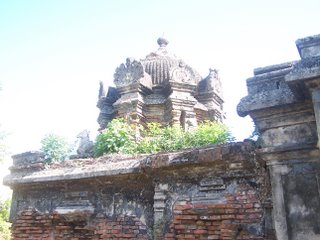
On enquiring, the priest there, said that the villagers had come together to re-build the temple. They were planning to demolish the existing structure and start building a new temple. Chandra almost screamed hearing this. We took the priest and a local villager around the temple, trying to explain to them why they cannot build an exquisite structure as that brick-built temple, in its present glory.
We took leave, after promising them that we would visit them again with Dr. T. Sathyamurthy, archeologist, to guide them as to how to preserve the old structure.
After breakfast at an Udupi hotel in Gummidipoondi, we entered pudhugummidipoondi and almost instantly located the paleeshwarar temple.
The Raja gopuram was in ruins, but through the hole in the huge wooden door, we could see a moderately well-maintained garden.
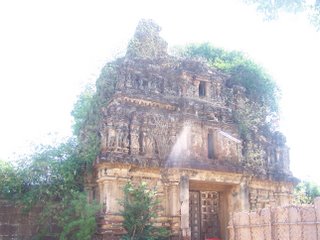
Later in the evening, when we went back, and forced a localite to ask the priest to come to open the temple for us, I was in for a (rude) shock when I saw the first hindu priest with a moustache, offering a visiting card for his astrology sessions.
Shock after shock. The priest was somehow able to get some money for renovation of the temple. The flooring of the inner-temple was marble, while the gopurams and rajagopuram were almost forested.
The carvings on the (what in our estimate was 400-800 year old temple) pillars were un-artistically painted with acrylic paint (a definite no-no, if you ask any acheologist worth his salt - or so says plasticschandra). The best example is a hanuman painted green with his tail painted in black. Am guessing they let a 6 year old kid practise his painting skills on the pillars.
Chandra, always the 'signs' guy now spotted a sign. A bearded old man (sanyasi?) who claimed to be a kali-upasakar. He was vague about where he came from and where he was headed. Like as if he were a wanderer, but was instructed by amman to be there on that day. He advised that whoever takes up renovation of the temple had to offer one goat, one pig and one chicken as sacrifice, because the temple was a kali-held temple, and the kali had to be pacified first.
Ramadoss and Senthil also scouted for how we could help the village. They went around talking to the village kids and parents about schooling facilities and what samarpanam could do to help the village.
A localite Mr. Chandrasekaran, came enquiringly, and took us to the village head, Mr.Selvaraj. Mr. Selvaraj was very hospitable and offered all help in getting the temples back to glory. We promised to return on the 16th of July with at least 50 people to clean up the temple. Mr. Selvaraj promised another fifty people and food for us.
We then visited the Chandrasekareswarar temple. This was another 400-800 year old temple, with no-gopuram style architecture. We noticed that some group had tried getting the temple back to shape in 2004, they had painted verses from tamil texts on the walls. But there was a lot of out-growth surrounding the temple. We were surprised that the priest was absent.
In the end of the narrow lane (which we guessed would have been the mada veedhi in the glory days of the temple), there was an old mandap - dilapidated and uncared for.

After surveying the compound, we decided that this would be one temple that really needed work. On coming out to of the temple, we ran into the priest at his home. I was surprised he wasn't willing to come out and perform pooja for the sake of us who visited the temple. But soon, I was to realize that this man was the father of the hairy-astrologer priest at the paleeshwarar temple, and that helped me understand the situation there vaguely (Little was I to realize what the graveness of the situation - all that in a later issue of the gummidipoondi files). The priest claimed that he had written many times to
the government officials, but HRCE was not helpful. The government had not paid him salary for this temple since 1995 and salary for the paleeshwarar temple since 1993. The government also did not provide for things necessary for pooja like oil, clothes and flowers.

We left pudhu gummidipoondi with a heavy heart, but confident of what we did that day and what work was pending. We had come at a time when the village head and the priests seemed cooperative and willing to do something about the temple. As a first step, we needed to gather 50-100 people to work on the outgrowths of the Chandrasekareshwarar temple. Later we need to sit with Mr. Selvaraj and the priests, as to how the local villagers can help support the temple's revival.
We seemed to have gotten a head-start in a task, temple and place not dared by many.
Folklore had it that many important temple patrons had tried to set things right about these temples but failed - which made the mission even more challenging.
On the way Plastics Chandra pointed out to a dilapidated temple which he claimed he saw everytime on this route. What was new even to him was that there were a couple of earth-movers and the area surrounding the temple looked cleaned-up and inviting.

On enquiring, the priest there, said that the villagers had come together to re-build the temple. They were planning to demolish the existing structure and start building a new temple. Chandra almost screamed hearing this. We took the priest and a local villager around the temple, trying to explain to them why they cannot build an exquisite structure as that brick-built temple, in its present glory.
We took leave, after promising them that we would visit them again with Dr. T. Sathyamurthy, archeologist, to guide them as to how to preserve the old structure.
After breakfast at an Udupi hotel in Gummidipoondi, we entered pudhugummidipoondi and almost instantly located the paleeshwarar temple.
The Raja gopuram was in ruins, but through the hole in the huge wooden door, we could see a moderately well-maintained garden.

Later in the evening, when we went back, and forced a localite to ask the priest to come to open the temple for us, I was in for a (rude) shock when I saw the first hindu priest with a moustache, offering a visiting card for his astrology sessions.
Shock after shock. The priest was somehow able to get some money for renovation of the temple. The flooring of the inner-temple was marble, while the gopurams and rajagopuram were almost forested.
The carvings on the (what in our estimate was 400-800 year old temple) pillars were un-artistically painted with acrylic paint (a definite no-no, if you ask any acheologist worth his salt - or so says plasticschandra). The best example is a hanuman painted green with his tail painted in black. Am guessing they let a 6 year old kid practise his painting skills on the pillars.
Chandra, always the 'signs' guy now spotted a sign. A bearded old man (sanyasi?) who claimed to be a kali-upasakar. He was vague about where he came from and where he was headed. Like as if he were a wanderer, but was instructed by amman to be there on that day. He advised that whoever takes up renovation of the temple had to offer one goat, one pig and one chicken as sacrifice, because the temple was a kali-held temple, and the kali had to be pacified first.
Ramadoss and Senthil also scouted for how we could help the village. They went around talking to the village kids and parents about schooling facilities and what samarpanam could do to help the village.
A localite Mr. Chandrasekaran, came enquiringly, and took us to the village head, Mr.Selvaraj. Mr. Selvaraj was very hospitable and offered all help in getting the temples back to glory. We promised to return on the 16th of July with at least 50 people to clean up the temple. Mr. Selvaraj promised another fifty people and food for us.
We then visited the Chandrasekareswarar temple. This was another 400-800 year old temple, with no-gopuram style architecture. We noticed that some group had tried getting the temple back to shape in 2004, they had painted verses from tamil texts on the walls. But there was a lot of out-growth surrounding the temple. We were surprised that the priest was absent.
In the end of the narrow lane (which we guessed would have been the mada veedhi in the glory days of the temple), there was an old mandap - dilapidated and uncared for.

After surveying the compound, we decided that this would be one temple that really needed work. On coming out to of the temple, we ran into the priest at his home. I was surprised he wasn't willing to come out and perform pooja for the sake of us who visited the temple. But soon, I was to realize that this man was the father of the hairy-astrologer priest at the paleeshwarar temple, and that helped me understand the situation there vaguely (Little was I to realize what the graveness of the situation - all that in a later issue of the gummidipoondi files). The priest claimed that he had written many times to
the government officials, but HRCE was not helpful. The government had not paid him salary for this temple since 1995 and salary for the paleeshwarar temple since 1993. The government also did not provide for things necessary for pooja like oil, clothes and flowers.

We left pudhu gummidipoondi with a heavy heart, but confident of what we did that day and what work was pending. We had come at a time when the village head and the priests seemed cooperative and willing to do something about the temple. As a first step, we needed to gather 50-100 people to work on the outgrowths of the Chandrasekareshwarar temple. Later we need to sit with Mr. Selvaraj and the priests, as to how the local villagers can help support the temple's revival.
We seemed to have gotten a head-start in a task, temple and place not dared by many.
Monday, July 10, 2006
Am Loving It
No, its not the domino's pizza.
Many people have tried convincing me that I do the temple cleaning working for a social cause. I refuse to be told *why* I do stuff, leave alone being told *what* to do.
I do it because am proud of the history of the land I was born unto. Am having fun walking the corridors, the Cholas walked and glorified. For all of you who dont beleive that, heres proof.
Picture courtesy Ramsundar (rac1c@yahoo.com)
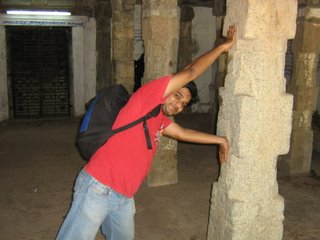
Many people have tried convincing me that I do the temple cleaning working for a social cause. I refuse to be told *why* I do stuff, leave alone being told *what* to do.
I do it because am proud of the history of the land I was born unto. Am having fun walking the corridors, the Cholas walked and glorified. For all of you who dont beleive that, heres proof.
Picture courtesy Ramsundar (rac1c@yahoo.com)

Navagraha sthalas near Chennai

We did manage to find the navagraha sthalas I mentioned in my previous posting. Fortunately, these temples were in good condition, if not very well-maintained. So, we didn't have much work here, but for the kethu sthala in gerukambakkam (gurukambakkam?). Chandrasekar aka plasticschandra has a well written post for every sthala, for which I have provided a map at http://puggy.symonds.net/~madan/navagraha/tour.html Dont forget to click on the red-dots to see chandra's blogger posts and pictures of each of the temples!
Fascinating thing is all these were chola-built (at least a thousand years old), and are built by the beautiful gajaprishta (like the back of an elephant) architecture. (see pic). Beautiful sight!
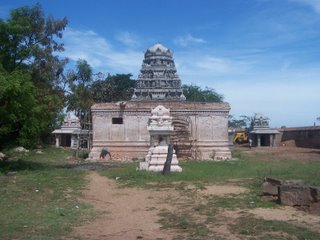
So, next time you have to do a parihaaram for one of the navagrahas, remember, you have these sthalas very close to Chennai. You dont have to travel all the way to the Tanjore district for dosha-parihaaram!
Actually it took us longer to upload the map and the pictures. In the meanwhile, we have visited a couple of dilapidated shrines in pudhu gummidipoondi. The village head has cordially agreed to help us with men and material to clean these temples as a first-step. More reports and pictures of pudhu gummidipoondi in my next blog. Stay tuned!
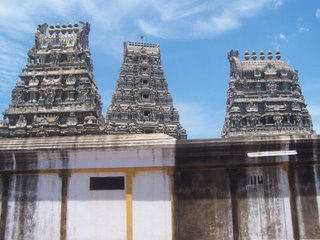
Thursday, June 22, 2006
Temple Cleaners

Temple cleaners is a group of people who are interested in cleaning up and reviving dilapidated temples of historical significance.
There are temple ruins all around us, but what are we doing about it? Do we realize that we are not only letting go a temple, but important historical facts, usually engraved and/or inscribed in the temple premises, as was the norm of the ancient tamil kings?
What happens when we revive temples like these?
- Recreate historical architecture
- Boost the local economy due to tourists and pilgrims
- Get a chance to protect and preserve ancient 'kalvettukal' that would otherwise be destroyed
- Refine our knowledge of our past, with information from these 'kalvettukal'
Do read http://templesrevival.blogspot.com/
Interested? Join us at http://groups.yahoo.com/group/temple_cleaners/
As a first step Chandrasekaran has taken the initiative to identify 9 temples - navagraha sthalas around Chennai (around Chennai?!!! yes, around Chennai), most of which are in ruins.
Five of us in the temple_cleaners groups are taking a survey of the status of these nine temples, to draw out a plan and time-table to revive them.
If you are too eager to know more, you could reach me on +91-98407-62326. I could put you in touch with more knowledgable people where I can't help.
Dont forget to come back here next week, when I report with pictures about our survey!
Tuesday, June 06, 2006
Ponniyin Selvan - yahoogroups meet on 4th July 2006.
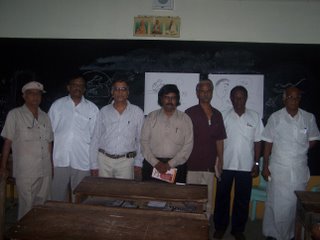
Minutes of the meeting:
Event : Meeting of the members of the ponniyin selvan yahoogroup (http://groups.yahoo.com/group/ponniyinselvan/) - The Perfect outfit to bring Historical facts to light
Scholors of various historical fields also attended.
Date : 4th July 2006, 6PM IST
Venue : Sri Ramakrishna mutt school, T. Nagar, Chennai.
Guests: Dr. Sathyamurthy, Suptt Archlgist, ASI (Retd)
T. N. Ramachandran, Epigraphist
Dr. Dasarathan, Palm-leaf specialist
Dr. Sathyanarayanan, Deputy Registrar, Sankara University
Mr. T. K. V. Rajan, eminent media personality
Mr. Swaminathan, thinnai.com
Mr. Ganesa Nadar
Sivapathasekaran (SPS) started the meeting introducing the various guests and members.
SPS also gave a short speech on how there has been a fusion that made the 'Ponniyin Selvan' group successful. He pointed out that the group was started and has the active participation of people from youngsters from the IT related industries. He pointed out that the shared enthusiasm of scholars to preserve ancient artifacts, and the techniques that could be provided by the youngsters could provide immense benefits. He also described how the efforts of the group moved from just being a literary group to interests in history and preservation of ancient tamil artifacts.
Dr. Sathyamurthy, Suptt Archeologist, ASI, then talked about the huge number of temples that are in ruins. He said that 60% of all stone-carvings in Indian history would be of the tamil origin. He noted the interesting fact that there was no oral-passage of knowledge (like vedas were passed orally down traditions) in the tamil culture, and suggested that this was proof that tamil had a well defined script far earlier than the north indian languages. He sadly observed that the governments mistakenly regard the historical tamil artifacts as non-secular, as they are mostly found in places of worship. He observed that the priest community should be more aware that simple stones lying in the temples could be of monumental importance, and hence should be involved in an effort to protect whatever is left of these ruined, un-protected artifacts.
Mr. T. N. Ramachandran then stole the show. He explained the distinction between hieroglyphics and a well defined phonetics based script. He showed with examples that hieroglyphs were a raw form of language, while phonetical scripts were more advanced, as there was no space for differing interpretations in the latter. He said, thus tamil was a more advanced language than what prevailed in the indus valley civilizations. He warned, however, that even though evidences about the antiquity of tamil/brahmi, and superiority over the indus valley civilizations are emerging day by day, we should not fall prey to over-enthusiasm and hype up not-so-well-defined-facts. This is because we are being watched with awe by all over the world, and we should not err in our claims. Rather we should let the facts talk for themselves.
Dr. Dasarathan, then talked of the unclaimed 'kalvettu'kkal in various parts of the country, and his rendezvous with "Kalvettum Katthirikkayum"! He also described how palm-leaf-writing could be of historical importance, and how many such historically significant palm-leaf-writings are spread throughout the land, without attempts at interpretations, which could significantly lead to a change of our current understanding of history.
Dr. Sathyanarayanan, then spoke at length about his interest in 'Ponniyin Selvan' and his association with Dr. Sathyamurthy. He offered to recommend to Sankara University, for a certificate course, if the group could come up with a write-up and syllabi. He said, this kind of work was more of the type that would have impressed Maha-periyava as the university was originally conceived to learn and enhance sanskrit works.
Mr. T. K. V. Rajan, then described the efforts by the media with regard to preservation of historical artifacts. He described some interesting anecdotes from "Kalvettu sollum kathai".
Mr. Swaminathan of thinnai.com and Ganesha Nadar expressed thier appreciation for the group.
Following small talks by various members on thier association with 'Ponniyin Selvan' and the group, the stage was set to discuss the proposed ephigraphy course.
With inputs from Mr. T. N. Ramachandran and Mr. Sathyanarayanan, SPS deftly steered the group discussion on the proposed course syllabi, duration, certification and timing & venue.
The decisions are as below:
- The course will of six month duration
- The course will include theory and field work
- Classes to be conducted for two hours on Saturdays and Sundays
- Students *must* attend at least 16 of the 24 theory classes in the first 3 months
- Certificates will be provided by Sankara University at the end of six months
- Venue not conclusively decided
Action items:
Team at large :
- Coordinate and followup on the efforts
- (To be assigned to somebody - SPS?) Create a write-up about the course to apply for
certification to Sankrara University
SPS :
- Decide and let the participants know about 4 venues, out of which one convenient venue
should be chosen.
Mr. T. N. Ramachandran:
- Prepare syllabi and field work curriculum
The meeting ended with informal networking and a short photo-session.
In serious company

I attended the 'Ponniyin Selvan' yahoogroups meeting at Ramakrishna mutt school on the 4th of June 2006. It was a revealing experience for me to know how involved the group was with history and preservation of the chola era artifacts.
Sweating my way through Ranganathan street - its like trying to swim in a barrell of tar nowadays. Maybe the government should think of a overpass to cross-over from one end of the street to another - I reached Ramakrishna school, where the groups members welcomed me warmly.
It was a fascinating to know that founder of the group - Ramachandran, was all of my age. He could even read the historical tamil used in the 'cholar kalvettukkal' (now, I wonder if the english word culvert originated from the word tamil word kalvettu.)
Some of the scholars present were, Dr. Sathyamurthy - Retd. Suppt, Archeological Survey of India,
Thiru. T. N. Ramachandran - epigraphist, Dr. Dasarathan - Palm leaf inscription specialist, Dr. Sathyanarayanan - Dty. Registrar of Sankara University, and other tamil 'arvalars' like Swaminathan of thinnai.com and Thiru. Ganesa Nadar
I was particulary fascinated by Mr. T. N. Ramachandran's speech on why phonetical scripts are more advanced than the hieroglyphs of the indus valley civilization.
I was also interested in a fact mentioned by Mr. Sathyamurthy - that oral passage of knowledge didnt exist in south india. This could mean that the tamil/brahmi based civilizations had already developed more advanced forms of writing, he said.
I laughed heartily when Dr. Dasarathan mentioned the pains of looking for historical artifacts with a comical event. He mentioned that himself and his colleague had gone in search of some 'kallvettukal' in the deeper parts of Tamil Nadu. The first week, they found some significant artifacts. After studying that, and enthused by the success of the first finding, they went back the next week to the same place. This week, they couldnt find anything of significance, but found that the place had some really huge brinjals. The friends ended up bringing some brinjals home. Not only that, they even wrote about it in "Kalvettum katthirikayum" - "Stone carvings and brinjals".
I was speechless, as the speeches by the scholors ranged from vanavarayan vandhiyathevan to hieroglyphs, with utmost ease.
What do I say? My, oh my! I was in serious company.
Subscribe to:
Comments (Atom)
